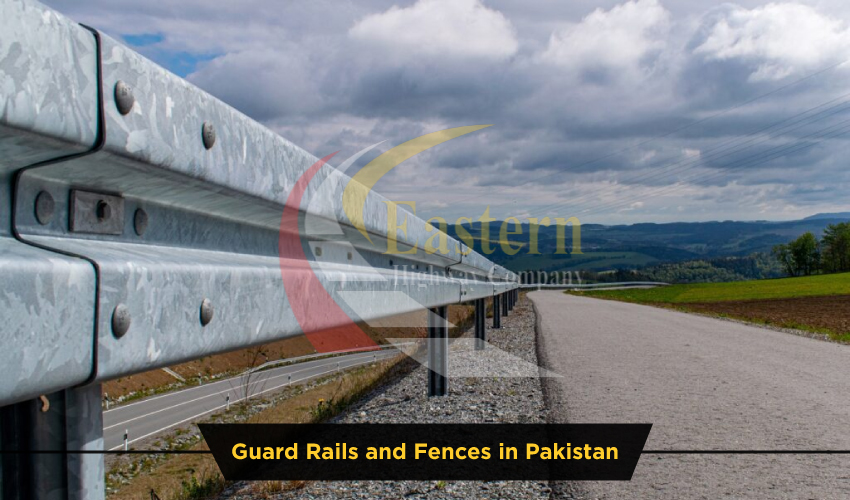Do you know what Guard Rails are? Have you ever been curious about the Guard Rails and Fences that you often see by the side of roads?
I was surprised to find out that these Guard Rails and Fences are made based on specific guidelines to serve a purpose.
Let us discuss in detail which Guard Rails and Fences are the best in Pakistan.
Understanding Guard Rails and Fences
A Guard rail is a barrier or stationary fence that is designed for the purpose of fall protection. It functions by preventing people from stepping over the edges of roads.
Road Barriers and Fences are designed so that dangerous spaces on the sides of roads are prevented from accessing. They are declared as off-limits areas while permitting light and visibility. Fences avert automobiles from tumbling off cliffs or running off the road or on the opposite side.
Guard Rails or Fences can also be used as momentary barriers to channel traffic in the chosen direction.
Eastern Highway offers three diverse types of road safety barriers. Each Barrier is made for suitable applications.
OSHA Guidelines on Guard Rails and Fences
OSHA (Occupational Safety and Health Administration) is the regulating body. It has made some guidelines that are important to follow. These guidelines are to be used when Guard Rails and Fences are made and Chosen for any business.
If these guidelines are not followed the users are put at rest. They might cause accidents in that case the concerned company will have to pay fines for noncompliance.
Eastern Highway makes all of its products based on OSHA guidelines. Some of the regulations are given as follows:
- OSHA 1910.29(b) refers to the part of the regulations which contain the system requirements employers must adhere to ensure employees’ safety against falling to the lower level.
- A guardrail comprises three primary components the top rails, mid-rails, and the posts. Each fence piece must comply with OSHA’s guidelines. It includes the material’s type, dimensions, height, and location.
- Bull guard rails, curbs for vehicles, or other barriers are practical, with a minimum of six inches (15.24 cm) in height. They must be installed at the water’s edges of bulkheads and pinafores. Except for areas where vehicles are not permitted. Bull rails or curbs installed on or after the 3rd of October, 1983, should be at least 10 inches (25.4 cm). 1917.112(a)(2)
- The rules under paragraph (a)(1) in this subsection also apply to the edges of any fixed height over the floor where vehicles can fall. However, it doesn’t include platform loading docks and skids, where cargo is transported by cars.
Benefits of Using Guard Rails &Fences on Roads
The primary goal of a Guard Rails on the road is to create a safety fence. It aids in protecting a driver who has drifted off the road.
Suppose an automobile runs off the road on one basis or another. In that case, the most helpful thing is for that car to come to rest unhampered.
Occasionally, however, that is not possible, and that is where guardrails come in.
In particular sites on any offered stretch of road, the road might have vertical barriers, side slopes, or even be blazed with trees.
The other barriers are Utility poles, bridge piers, and controlling walls. In these circumstances, hitting a Guard Rail would be better to traversing the fences. Hence, barriers are usually established.
They lessen the severity of a potential crash and make the roads safer.
The guardrail can work in diverse ways, from driving a vehicle back onto the road, slowing it down, or stopping it.
In some circumstances, it delays it adequately and permits it to move past the guardrail.
Fences are not 100% foolproof, but they do support them.
The height of the automobile and the speed with which it strikes the road fence plays a role in how useful the barrier is in delaying a vehicle.
Before guardrails are established, engineers consider all the possible elements to guarantee that the arrangement works as well as possible in all situations.
The guardrail itself operates as a whole technique instead than just stand-alone segments. Each component performs a distinct purpose as part of the whole.
Everything from the posts that are driven into the land to how the guardrail links to the post are important and play a part.

Parts of a Guard Rails & their Functions
The end terminal and the anchoring system at the end terminal are just as important. But in general, the road barrier consists of two key parts; the guardrail front and the end terminal.
The guardrail face is precisely what it sounds like; the portion that stretches from the terminal along the road. Its role is easy and consistently the same. It redirects a vehicle that runs into it back onto the road.
The end terminal is the starting and ending point of the guardrail and is also guided to as the end remedy. The end ought to have ministered with some sort of energy-absorbing material. This is because the effect from a vehicle is engrossed and then slides down the rail.
The end terminal processes in two ways;
If a vehicle hits head-on, the consequence head glides down the guardrail, turning it away from the vehicle until the energy from the impact has dispersed. Then, the vehicle has come to a stop.
When a car strikes an angle, the effect head may extrude the barrier or gate out, letting the vehicle pass behind the guardrail. So, in this example, the guardrail is driven through, much like the action of a gate entrance.
Pedestrian Fencing
Pedestrian fencing, another name for Guard Rail, is used on the flank of a road or within the median. It is installed to limit pedestrian access to the roads. In addition, it helps in lowering the clash between motorized cars and pedestrians.
Fencing is usually utilized to control pedestrians to a desired formal crossing point. However, it also works by preventing pedestrians from making risky crossing movements where visibility may be minor.
Creative solutions can be reached through good road design utilizing road effects, planting, and public art to guide and direct pedestrian movements.
In addition, methods must evaluate weak road users’ conditions and mobility damage.
Functions of Pedestrian Fences
Pedestrian Fences or Guard Rails serve the following Functions:
- First, it helps to direct pedestrians to standard crossing ends.
- It can help to control undesirable pedestrian crossing motions.
- Physically contains pedestrian entry to the roads.
- Aids to stop pedestrians from running out from pedestrian paths crossing the road at the right angle.
- It helps to deter crowds from unexpectedly slopping out onto the road at exits of schools, cinemas, buildings, etc.
- It can help to prevent drivers from parking on the pathway.
- Supplies practical direction for visually impaired pedestrians.
Characteristics of Guard Rails & Fences
Usually, motorway fences are made using metal mesh. It is electro-welded and presents differentiated meshes.
It is thinner and denser at the base. This helps to control any shot at intrusion by wild animals or people, evolving slowly wider towards the top.
They are generally slightly one meter high. Usually, they are installed with U-shaped or T-shaped posts at 2-meter breaks and supported with strain wires.
To deliver extra stability to the entire fence, upwind posts are usually installed every 30 meters, with a cornerstone position every 90 to 100 meters.
Along some distinct areas of the road network, the peak of the wire mesh can be as elevated as 120/190 centimeters. This is the chance when the road crosses large wild areas, runs close to other secondary roads or railway lines, or is in areas with a high risk of wildlife crossing.
Given the high traffic speed on motorways, designing and building a fencing system that meets all the necessary safety requirements is essential. Furthermore, it should ensure exceptional performance over time in terms of durability, ease of maintenance, and resistance.
In addition, we should carefully consider the constant exposure to mechanical stress, atmospheric agents, and temperature changes.
From this point of view, it is also important to promote projects to upgrade motorway fencing. It should consider the features of the road and its surroundings and appreciate the specific protection essentials for both road users and animals.
Guard Rails & Fences Provided By Eastern Highway
Guard Rails
A crucial part of the road is the guard rail.
The boundary feature protects road users and pedestrians from danger zones and unsafe regions.
Additionally, they create space for light and visibility on the road, assuring the security of users and pedestrians. Additionally, safety railings are installed in many public areas to prevent falls and provide stability when walking.
Recognizing the strength and protection provided by a safety rail is essential. Although they frequently go unnoticed, they are a perfect public safety answer.
They are meant to withstand direct collisions from automobiles and are made of galvanized steel. Our guard rails are made to be bolted or anchored into the ground to provide the most and most long-lasting protection.
For increased aesthetics, our safety rails are available in various finishes, and high visibility alternatives are also available. We also offer fencing perfect for dividing spaces at public gatherings, sporting events, and other institutions.
Chain Link Fencing Galvanized
We offer high-quality chain link fencing that has been galvanized and topped with razor wire.
It is a form of woven fence often built from wire that has been galvanized. The zigzag pattern is created by vertically bending the chain-link fence wire so that each “zig” hooks the wire immediately on one side and each “zag” joins the wire immediately on the other.
This steel fence’s diamond pattern is reminiscent of a chain link fence. Although virtually any height is conceivable, common chain link fence heights include 3′, 4′, 5′, 6′, 7′, 8′, 10′, and 12′.
Common mesh sizes are 6, 9, and 11, although we offer them based on clients’ needs and specifications.
Cable Barrier System
A cable barrier system is a type of road or median safety traffic barrier/guard rail, often known as a guarded cable or wire rope safety barrier.
Steel wire ropes set on supports make up the structure. Like any roadside barrier, its primary function is to stop a car from veering off the beaten path and colliding with a fixed object or less forgiving piece of terrain.
Cable barriers work similarly to most roadside barriers by catching and rerouting the offending vehicle.
Because installing and maintaining these barriers is less expensive than doing the same with concrete step barriers.
They have excellent vehicle capture efficiency. Because of this, their use is spreading around the globe.
Conclusion
The safety of the Public is our Prime responsibility. This is the mission Eastern Highway follows while designing stable and strong Guard Rails and Fences for Roads. In order to get the Best road marking and safety services you can visit the website.
Frequently Asked Questions:
What is the difference between a fence and a railing?
A fence is a structure designed to enclose an area for privacy, security, or boundary definition, typically used outdoors. A railing is a handrail or barrier meant to prevent falls and provide support, often found along staircases, balconies, or decks.
What is the purpose of guard rails?
Guard rails are designed to prevent people or vehicles from accidentally straying into dangerous or off-limit areas, such as edges of elevated surfaces, roadways, or hazardous zones.
What are the 4 general types of guardrails?
The four general types of guardrails are:
- Highway guardrails for vehicle safety on roads.
- Industrial guardrails for protecting machinery and workers.
- Architectural guardrails for balconies, stairs, and walkways.
- Roof edge guardrails for fall protection in construction and maintenance.
What are fence rails for?
Fence rails are horizontal components of a fence that connect and support the vertical posts or pickets, providing structural integrity and stability to the fence.






